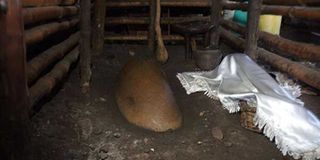Fabled Luo warrior Luanda Magere still revered by many

The rock that is believed to be the head of Luo legendary warrior Luanda Magere. The site where the stone lies along Nyando River in Kisumu is revered by the Luo community and attracts hundreds of visitors. PHOTO | TONNY OMONDI | NATION MEDIA GROUP
What you need to know:
- Luo folklore speaks highly of this worrier, saying he could not be easily killed in battle.
- He hailed from Kano and was from the Sidho clan.
- According to folklore, Nandi warriors had terrorised the Luo for long, serving them defeat after defeat.
Every community has their Luo folklore own hero or heroine who is revered for standing out and defending his or her people from aggression by enemies.
And such legends are said to have extra-ordinary powers that other humans beings do not have.
Such is the story of a brownish curved rock along Nyando River in Kisumu which is probably the most revered stone in Kenya.
Many brave the rough terrain and narrow pathways that lead to the site just to catch a glimpse of it.
LUO WARRIOR
The stone, which is partially sunk in the ground, is believed to be the head of Luanda Magere (also Lwanda Magere), the legendary Luo warrior.
Luo folklore speaks highly of this worrier, saying he could not be easily killed in battle.
He hailed from Kano and was from the Sidho clan.
It is said that arrows, spears and clubs from enemies would simply bounce off his body.
When he was eventually killed by an enemy, the folklore says his body turned into a stone.

A woman prays at the Luanda Magere site in Kisumu on May 22, 2019. PHOTO | TONNY OMONDI | NATION MEDIA GROUP
REVERED
The place believed to be Luanda Magere’s final resting place remains revered by the Luo people, with a belief that the stone that protrudes from the ground is his head.
The stone is enclosed in a hut surrounded by leafy indigenous trees that provide shade, a welcome relief to the hundreds that make their way here to behold the rock, which, residents believe comes with good tidings.
Many believers come here to consult the spirit of this legendary warrior.
Luanda Magere is said to have led the Luo community in numerous victories against the neighbouring Nandi community until they finally found a way to kill him — they offered him a beautiful woman who, using her feminine wiles, deciphered the secret behind his strength.

The entrance to the Luanda Magere site in Kisumu. PHOTO | TONNY OMONDI | NATION MEDIA GROUP
TERRORISED BY NANDI
Before this, according to folklore, Nandi warriors had terrorised the Luo for long, serving them defeat after defeat.
This changed with the emergence of Luanda Magere, a hero who led his community in numerous battles against the Nandi, emerging victorious each time.
Due to his courage and strength, women were attracted to him, and he, in fact, according to folklore, had 25 wives.
And then a false gesture of peace and friendship was offered to him by the enemy of his people.
The elders pleaded with him to reject the offer but he would not listen.
DOWNFALL
This would lead to his downfall because the woman’s true mission was to discover the secret of Luanda Magere’s strength.
The trickery the Luo elders had suspected came into being.
One day, Luanda Magere disclosed to his foreign wife that he would only die if his shadow was pierced by an arrow or spear.
To protect the source of his invincibility, he always fought in the evening or at night when there was no shadow to pierce.
His wife revealed this secret to her people who then lured him to a daylight battle.

The hut that houses the Luanda Magere stone in Kisumu. PHOTO | TONNY OMONDI | NATION MEDIA GROUP
TURNED INTO ROCK
That is how Luanda Magere died, and when he did, legend has it that he turned into a rock.
At the Luanda Magere site are traditional war weapons, including a spear and shield, said to have been used by the Luo hero in battle.
The weapons are placed under an indigenous tree next to the rock.
There is also a traditional smoking pipe, which Magere is believed to have been smoking as he battled his Nandi and Kipsigis adversaries.
There is also a framed-picture of the founder of the Legio Maria sect Melkio Ondetto who died in 1992.
So revered is the site that pregnant women are not allowed to step in since it is believed that if they do, they will miscarry.
Some residents claim they at times come across skeletons of people killed in the wars that fought at the turn of the 18th century.





